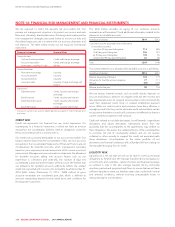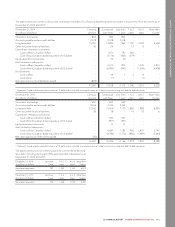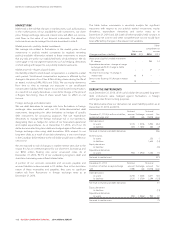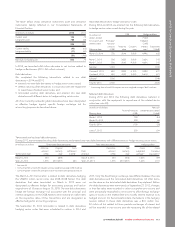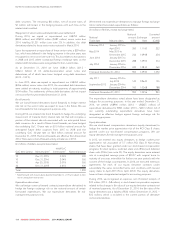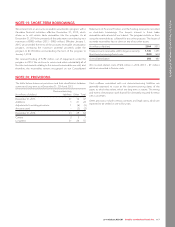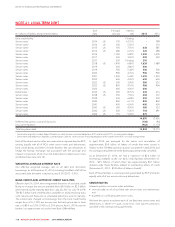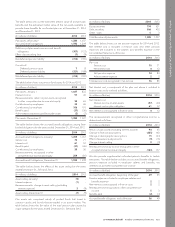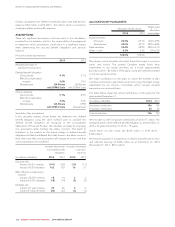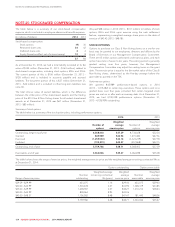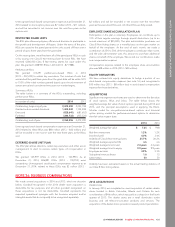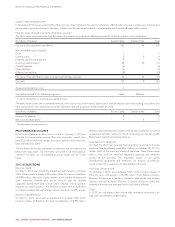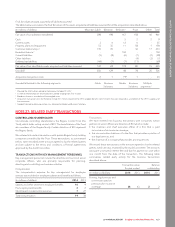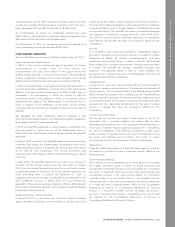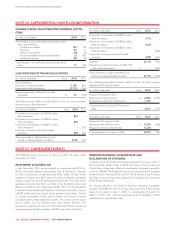Rogers 2014 Annual Report Download - page 124
Download and view the complete annual report
Please find page 124 of the 2014 Rogers annual report below. You can navigate through the pages in the report by either clicking on the pages listed below, or by using the keyword search tool below to find specific information within the annual report.
NOTES TO CONSOLIDATED FINANCIAL STATEMENTS
NOTE 22: OTHER LONG-TERM LIABILITIES
(In millions of dollars) Note 2014 2013
Deferred pension liability 23 321 189
Supplemental executive retirement plan 23 56 49
Stock-based compensation 25 37 36
Other 48 54
Total other long-term liabilities 462 328
NOTE 23: POST-EMPLOYMENT BENEFITS
We have contributory and non-contributory defined benefit pension
plans that are made available to most of our employees. The plans
provide pensions based on years of service, years of contributions and
earnings. We do not provide any non-pension post-retirement
benefits. We also provide unfunded supplemental pension benefits to
certain executives.
We sponsor a number of pension arrangements for employees,
including defined benefit and defined contributions plans. The Rogers
Defined Benefit Plan provides a defined pension based on years of
service and earnings, and with no increases in retirement for
inflation. Participation in the plan is voluntary and enrolled employees
are required to make regular contributions into the plan. In 2009 and
2011, we purchased group annuities for our then retirees. Accordingly,
the current plan members are primarily active Rogers employees as
opposed to retirees. An unfunded supplemental pension plan is
provided to certain senior executives to provide benefits in excess of
amounts that can be provided from the defined pension plan under
the Canada Income Tax Act’s maximum pension limits.
We also sponsor smaller defined benefit pension plans in addition to the
Rogers Defined Benefit Plan. The Pension Plan for Employees of Rogers
Communications Inc. and the Rogers Pension Plan for Selkirk Employees
are legacy closed defined benefit pension plans. The Pension Plan for
Certain Federally Regulated Employees of Rogers Cable
Communications Inc. is similar to the main pension plan but only federally
regulated Cable business employees are eligible to participate.
In addition to the defined benefit pension plans, we also provide defined
contributions plans to certain unionized New Brunswick employees,
employees of the Toronto Blue Jays and Rogers Centre, and some US
subsidiaries. Additionally, we also provide other tax-deferred savings
arrangements including a Group RRSP and a Group TFSA program which
are accounted for as deferred contribution arrangements.
The assets of the defined benefit pension plans are held in segregated
accounts isolated from our assets. We administer the defined benefit
pension plans pursuant to applicable regulations, the Statement of
Investment Policies and Procedures and to the mandate of the Pension
Committee of the Board of Directors. The Pension Committee of the
Board of Directors oversees our administration of the defined benefit
pension plans, which includes the following principal areas:
• overseeing the funding, administration, communication and
investment management of the plans;
• selecting and monitoring the performance of all third parties
performing duties in respect of the plans, including audit, actuarial
and investment management services;
• proposing, considering and approving amendments to the defined
benefit pension plans;
• proposing, considering and approving amendments of the
Statement of Investment Policies and Procedures;
• reviewing management and actuarial reports prepared in respect of
the administration of the defined benefit pension plans; and
• reviewing and approving the audited financial statements of the
defined benefit pension plan funds.
The assets of the defined benefit pension plans are invested and
managed following all applicable regulations and the Statement of
Investment Policies and Procedures with the objective of having
adequate funds to pay the benefits promised by the plan, and reflect
the characteristics and asset mix of each defined benefit pension plan.
Investment and market return risk is managed by:
• contracting professional investment managers to execute the
investment strategy following the Statement of Investment Policies
and Procedures and regulatory requirements;
• specifying the kinds of investments that can be held in the plans and
monitoring compliance;
• using asset allocation and diversification strategies; and
• purchasing annuities from time to time.
The funded pension plans are registered with the Office of the
Superintendent of Financial Institutions and are subject to the Federal
Pension Benefits Standards Act. The plans are also registered with the
Canada Revenue Agency and are subject to the Canada Income Tax
Act. The benefits provided under the plans and the contributions to
the plans are funded and administered in accordance with all
applicable legislation and regulations.
Significant estimates are involved in determining pension-related
balances. Actuarial estimates are based on projections of employees’
compensation levels at the time of retirement. Maximum retirement
benefits are primarily based on career average earnings, subject to
certain adjustments. The most recent actuarial valuations were
completed as at January 1, 2014.
There are risks related to contribution increases, inadequate plan
surplus, unfunded obligations and return risk for the defined benefit
pension plans, which we mitigate through the governance described
above.
120 ROGERS COMMUNICATIONS INC. 2014 ANNUAL REPORT


